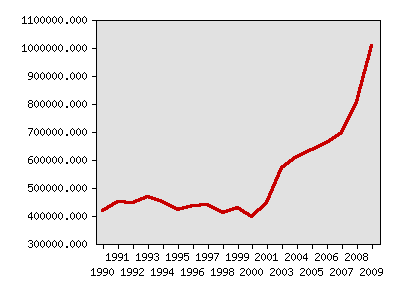What were things like in 2002?
The following idicator summary is from the 2002 Minnesota Milestones and does not neccessarily reflect the current data trends.
Indicator : Food shelf use
Rationale: Food shelf use gives some indication of the number of Minnesotans requiring assistance with this basic need, and the availability of food assistance to help them.
About this indicator: From 2000 to 2001, household visits to food shelves increased by twelve percent. This is the largest single year increase in more than a decade. A network of food banks and food shelves serves low-income Minnesotans. The numbers reported here include multiple visits by the same household. According to Hunger Solutions Minnesota (formerly the Minnesota Food Shelf Association), even though the number of household food shelf visits decreased between 1998 and 2000, the number of visits per household increased from 5.3 per year in 1995 to 6.1 in 2000. It is estimated that one in 22 Minnesotans received help from a food shelf in 2001. One-half of the individuals served at food shelves in 2001 were children; 20 percent were seniors.
In addition to local food shelf use, qualified people can participate in the national Commodity Supplemental Food Program, which provides food stamps and other food programs through national grants to states. In 2001, Minnesota agencies distributed over 4 million pounds of U.S. Department of Agriculture commodities worth over $3 million. The seven regional food banks distributed USDA commodity foods to approximately 300 food shelves and 900 on-site meal programs and shelters throughout the state.
Household visits to food shelves

Household visits to food shelves
| Year | Data |
|---|
| Household visits to food shelves, Hunger Solutions Minnesota
|
|
1990 |
416,552 |
|
1991 |
449,232 |
|
1992 |
446,175 |
|
1993 |
465,977 |
|
1994 |
447,213 |
|
1995 |
421,369 |
|
1996 |
433,214 |
|
1997 |
435,881 |
|
1998 |
408,335 |
|
1999 |
425,583 |
|
2000 |
396,002 |
|
2001 |
443,939 |
|
2003 |
571,031 |
|
2004 |
609,730 |
|
2005 |
634,116 |
|
2006 |
660,476 |
|
2007 |
695,004 |
|
2008 |
805,207 |
|
2009 |
1,006,714 |
For comparison: No national figures are available for comparison.
Things to think about: Although 43 percent of households using food shelves in 2000 reported employment as their main source of income, 82 percent of these households had incomes below the poverty line.
Technical notes: Minnesota had 310 food shelves in 2001; 258 participated in the survey. One-third are in the Twin Cities metro area. Contributors include Minnesota FoodShare (a program of the Greater Minneapolis Council of Churches), the Minnesota Food Bank Network, individuals, congregations and other volunteer groups.
In Minnesota Milestones 1998, the source for data was The Urban Coalition, Minnesota Food Shelf Use Statistics. In 1999, the source was Hunger Solutions Minnesota.
The survey of household characteristics of food shelf users was conducted by Hunger Solutions Minnesota in July 2000. Participants of the confidential survey were clients of 18 on-site meal programs and 152 food shelves. This participation represented approximately 60 percent of all households served by these agencies.
Sources:Hunger Solutions Minnesota, Working, But Still Hungry, February 2001, www.hungersolutions.com
Minnesota FoodShare, www.gmcc.org
Minnesota Department of Children, Families & Learning, http://www.cfl.state.mn.us/
Related 2002 Milestones indicator:
Other related indicators:
- Minnesotans enrolled in MinnesotaCare, Medical Assistance and related health care programs (Minnesota Department of Human Services, www.dhs.state.mn.us)
- Minnesotans receiving government subsidies for child care (Minnesota Department of Children, Families & Learning, www.children.state.mn.us)
Local data:


Milestones is a product of the Minnesota State Demographic Center, a division of the Department of Administration






